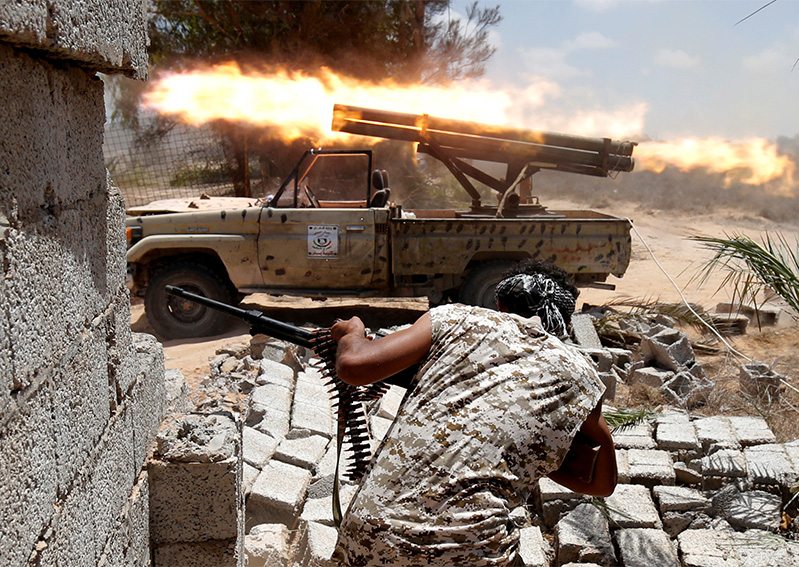
Discord among rival camps in Libya and their external backers continues to hamper the stabilisation process, making the creation of a unified military an unlikely goal in the short term, like reported by iiss.org.
The aim of re-establishing a unified military in Libya, which has been convulsed by violent factionalism since the overthrow of the former leader, Muammar Gaddafi, in 2011, may be a laudable one, endorsed at a recent international conference in Italy involving rival Libyan armed groups and international partners. The delivery of such a goal, however, is unlikely in the short term. Continuing violence and divergent ambitions among key leaders in the country and the clashing agendas of the international players involved risk undermining the effort.
The international gathering in Palermo on 12–13 November involved several Libyan factions, 31 countries and European Union and African Union representatives. Conference attendees supported the long-standing Egyptian-led initiative to reconstitute a unified professional military. This would be accountable to Libyan civilian authorities. Pulling together the rival armed groups which are made up of former regular military, tribal militias and armed civilians, however, is an extremely ambitious task.
Rival factions
The disparate paramilitaries have massed under two main banners: Marshal Khalifa Haftar’s Libyan National Army (LNA) in the eastern part of the country, and Fayez al-Sarraj’s Government of National Accord (GNA) in the west.
Reportedly the LNA totals up to 25,000 personnel, with at its heart a number of brigade-size units, including former Gaddafi-era Libyan military. Additional personnel are drawn from the Saiqa, a special forces unit that also counts former Gaddafi-regime soldiers amongst its number. Further manpower is provided by Madkhali Salafist militia units, Chadian and Sudanese mercenaries as well as armed tribal groups and petroleum facility guards.
The GNA can count on a larger support base of militias, although some are prone to infighting. This lack of unity was reflected in last August’s clashes between GNA-affiliated forces and the Tarhuna 7thBrigade, which was supposedly part of the same faction.
Within this loose grouping supporting the GNA, there are also those whose allegiance is driven only by opportunism. The largest armed groups in the west include the Misrata militias and the Zintani forces, with the latter split in their support between the GNA and LNA. In the capital, Tripoli, the GNA’s backers include the Rada Special Force, a police force comprising around 1,500 personnel and the 700-strong Nawasi brigade, led by Islamists. These militias are the best trained and equipped in the capital.
External actors
While there has been no official recognition that the LNA has been the beneficiary of training or a technical advisory programme, there are significant claims of external support and supply of equipment. The United Nations Panel of Experts says that the United Arab Emirates is the source of Panthera T6 and Tygra armoured vehicles delivered in April 2016 to the LNA. It is also noteworthy that the UAE has already built an airbase in Al Khadim, south of the city of Marj in eastern Libya. In 2017, the UN panel also claimed that Egypt might have conducted some air strikes to support the LNA’s attempt to recapture oil terminals along the eastern coast of the Gulf of Sirte. Egypt denied the UN suggestions that it had provided air support.
In western Libya, the ongoing infighting amongst the rival factions has made it difficult for the GNA to deal with human trafficking. Trafficking is a primary concern for the EU. To this end, since June 2016, the EU has provided training and assistance to the Libyan Coast Guard and Navy under the EUNAVFOR operation Sophia. According to the EU’s estimates, by the end of its mandate in December 2018, over 300 personnel will have been trained to perform maritime security and search and rescue operations.
Similarly, in January 2018, Italy announced its Bilateral Mission of Assistance and Support in Libya. This extended and expanded its Libyan Coast Guard Mission and operation Ippocrate to provide limited medical support on a limited basis. Military training under the bilateral accord includes amphibious assault training, and the repair and return to service of a number of Libyan patrol craft and transport aircraft. In addition,12 second-hand Class 500 and two Corrubia-classpatrol boats are also to be provided. These were formerly operated by the Italian Coast Guard and the Guardia di Finanza.
While EU reports suggest that EUNAVFOR Sofia’s mandate might be extended until 2020, it is still unclear whether Italy will renew its bilateral mission.
As 2018 draws to its end, the LNA and GNA-supporting militias have remained fragmented, and on occasion fractious, hampering the stabilisation process. There is also the enduring challenge from ISIS, and the efforts to counter it. Both the LNA and the forces loyal to the GNA also still rely on military aid from external actors, in turn pursuing their own agendas. In such a complex environment, unifying even the bulk of the factions to create a functioning central armed force is unlikely any time soon.


